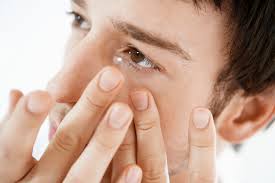What are the indications for contact lens use?
A thorough examination of each patient’s history, medical conditions, expectations and responsibility, refractive needs, and response to trial fitting determines whether contact lenses are appropriate.
The principal indications for contact lens fitting are as follows.
Optical Indications
Most contact lens wearers fall into this group. The great majority are myopic with or without astigmatism.
Medical Indications
Keratoconus
Keratoconus is a bilateral, but asymmetric, progressive thinning of the cornea. Such cases are generally fitted with rigid gas permeable contact lenses to correct myopia and irregular astigmatism resulting from the corneal irregularity and ectasia.
The contact lens does not inhibit the progression of the disease and is used only when the visual acuity obtained with glasses becomes unsatisfactory.
Irregular Astigmatism and Corneal Opacification
Rigid contact lenses provide an excellent means of correcting irregular astigmatism associated with corneal opacification by eliminating the aberrations and glare, leading to better visual acuity.
The fitting of a contact lens in these cases is almost always undertaken prior to considering corneal transplantation. For the most part, rigid gas permeable lenses provide better results, although hydrophilic lenses may have utility in selected cases.
Anisometropia
Anisometropia exists when there is a difference in the refraction of generally more than two diopters between the two eyes. Uncorrected
anisometropia in the infant may lead to amblyopia, especially when one eye is hypermetropic.
In the adult, differences of greater than three diopters generally are not tolerated with spectacle correction. In such cases, a contact lens may be indicated in order to reduce the develop- ment of amblyopia and anisometropic aniseikonia.
Unilateral Aphakia
Unilateral aphakia induces significant disparity in image size (anisei-konia). Anisometropic correction with glasses produces intolerable an- iseikonia, with a difference in image size of approximately 30%.
The contact lens diminishes the aniseikonic image difference to approximately 7%—a difference generally not perceptible to the visual cortex.This reduces the magnifying effect of the positive lens, permitting binocular vision.
Nystagmus
When it is necessary to correct ametropia in patients with nystagmus, contact lenses offer advantages over glasses, because contact lenses follow the movement of the eye and, in many cases, permit better visual acuity.
After Refractive Surgery
Patients with significant residual ametropia after surgery may have their ametropia corrected with a contact lens. Contact lens fitting may be initiated 3 to 6 months after surgery.
In most cases, rigid gas permeable lenses are appropriate, and a reverse-curve design is most commonly used.
Special care must be taken to consider the degree of corneal topography, vascularization , and the possibility of epithelial erosions.
After Penetrating Keratoplasty
A contact lens is indicated in cases with large refractive errors, anisometropia, or irregular astigmatism after corneal transplantation.
Fitting is usually initiated no sooner than 3 months and often 6 to 12 months after surgery, and contact lenses are primarily used when there is persistent regular or irregular astigmatism after removal of the sutures.
Cosmesis
Prosthetic, tinted lenses are often used in patients with a disfiguring corneal scar or an iris coloboma to improve the aesthetics of a non seeing eye or to occlude an iris coloboma. Cosmetic lenses may also simply be used to alter the color of the eye.
Therapeutic Lenses
Although every contact lens may be considered ‘‘therapeutic,’’ therapeutic lenses are those that are applied specifically for treatment of a corneal disease.
RRB OPTOMETRIST Exam preparation
2️⃣ Ophthalmogy MCQ test series
3️⃣ Ophthalmogy and Optometry MCQ Quizz series
4️⃣ Free Attend online Optometry quiz test
5️⃣ Join Optometry course for exam govt exam preparation
To get optometry vacancy update join Channel below
1️⃣ WhatsApp Channel
2️⃣ YouTube Channel
3️⃣ Facebook Page
4️⃣ Telegram Channel
Tags:
Contact lens

